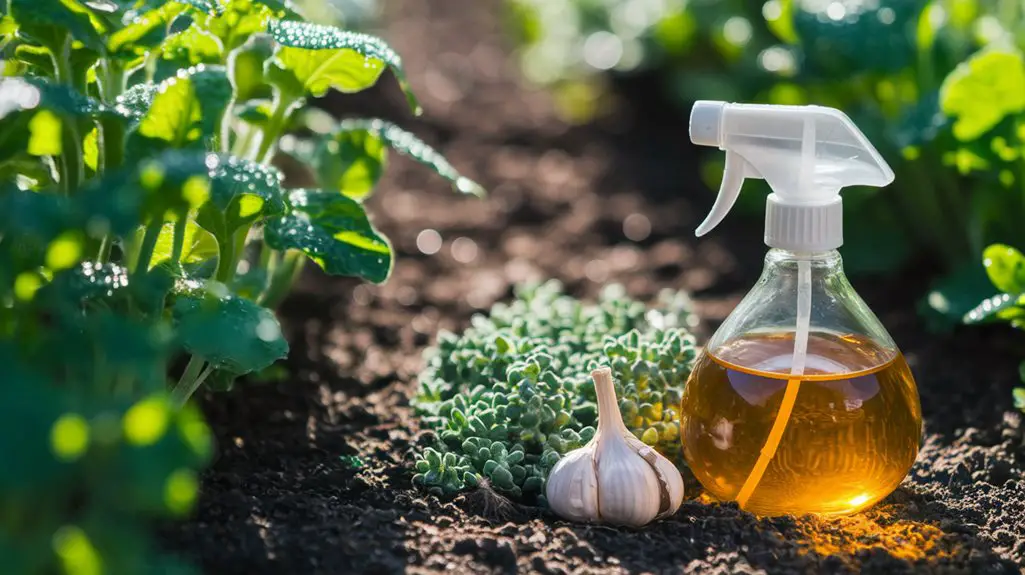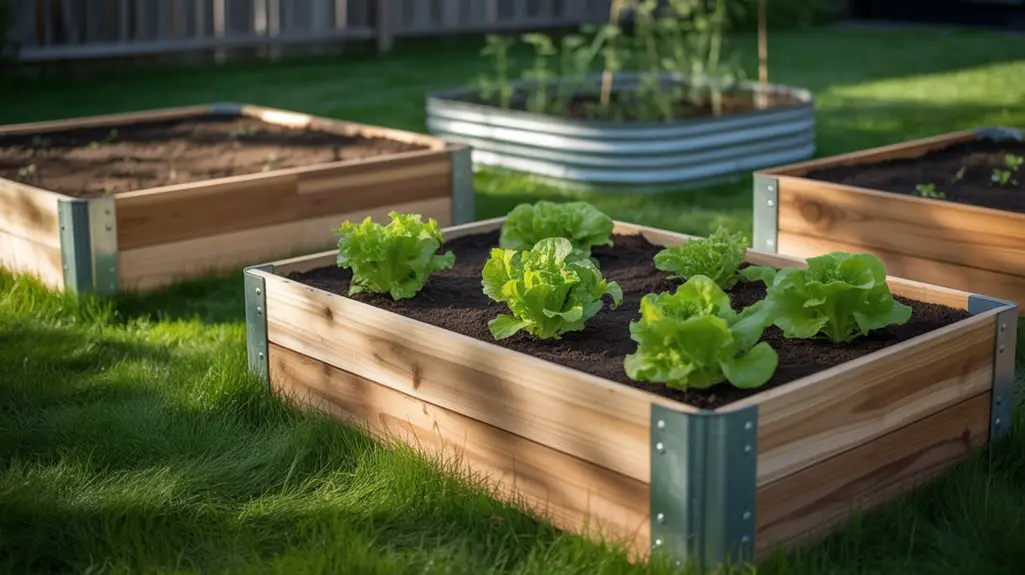While commercial pesticides line garden center shelves with promises of quick pest elimination, your kitchen cupboard likely holds equally effective and far safer alternatives. You’ll find that homemade repellents offer targeted protection without introducing harmful chemicals to your backyard ecosystem. Most DIY solutions require just minutes to prepare yet provide days of protection against common garden invaders. The secret lies not in one universal remedy, but in matching the right natural deterrent to each specific pest problem.
Common Garden Pests and Their Damage Signs
While enjoying your garden, you’ll inevitably encounter a variety of destructive pests that can quickly damage or destroy your plants.
Aphids leave sticky residue and cause leaves to curl or yellow. Spider mites create fine webbing and stippled discoloration on foliage. Slugs and snails produce ragged holes in leaves and leave silvery slime trails.
Caterpillars chew irregular patterns along leaf margins, while cutworms sever seedlings at soil level. Japanese beetles skeletonize leaves, consuming tissue between veins. Squash bugs cause wilting and yellow spotting on cucurbits.
Tomato hornworms devour entire leaves and stems overnight. Look for frass (insect excrement), eggs on leaf undersides, and distorted new growth as early warning signs. Implementing effective natural insecticides can help manage these pest populations without harming beneficial insects.
Identifying specific pests by their characteristic damage patterns allows you to implement targeted homemade remedies promptly.
Essential Oil Sprays for Insect Management

Essential oil sprays represent a powerful natural alternative to chemical pesticides for managing garden insects. These concentrated plant extracts contain compounds that disrupt pest behavior while maintaining ecosystem balance.
Create effective sprays by mixing 10-15 drops of essential oil with 1 cup of water and 1 teaspoon of castile soap. Peppermint repels aphids and spider mites; neem disrupts feeding and reproductive cycles; lavender deters whiteflies and moths; while tea tree combats fungal issues that attract pests.
Apply your spray during early morning or evening when beneficial insects are less active. Focus on leaf undersides where pests often hide.
You’ll need to reapply every 5-7 days and after rainfall for continuous protection. These formulations break down naturally without leaving harmful residues in your garden soil. Additionally, using organic pest control methods can enhance your overall garden health and resilience against future infestations.
Garlic and Onion Pest Deterrents

Sulfur compounds found in garlic and onion bulbs create powerful natural deterrents against common garden pests. These organosulfur compounds, particularly allicin and diallyl disulfide, disrupt insects’ olfactory receptors and interfere with their feeding patterns. To prepare an effective spray, crush 4-5 garlic cloves and one medium onion, then steep in 4 cups of water for 24 hours. Strain the mixture, add 1 tablespoon of mild liquid soap as an emulsifier, and transfer to a spray bottle. Apply to affected plants bi-weekly during early morning or late evening hours. This solution effectively repels aphids, spider mites, cabbage loopers, and Japanese beetles. You’ll notice it’s particularly effective against soft-bodied insects while being harmless to beneficial pollinators when used correctly. Additionally, these natural methods can be part of an integrated pest management strategy for your garden.
Soap-Based Solutions for Soft-Bodied Insects
Similar to garlic and onion preparations, soap-based insecticides offer an effective and readily available option for controlling soft-bodied insects in your garden. These solutions work by breaking down the protective waxy coating on insects, causing dehydration and death.
| Insect Type | Soap Ratio | Application Frequency |
|---|---|---|
| Aphids | 1 tbsp/quart | Every 5-7 days |
| Whiteflies | 2 tbsp/quart | Weekly |
| Spider Mites | 1.5 tbsp/quart | Every 3-5 days |
For best results, use pure castile soap or insecticidal soap rather than dish detergent, which may contain additives harmful to plants. Apply your solution during early morning or evening to prevent leaf burn, and always test on a small leaf area first. You’ll notice these mixtures work best on direct contact with pests, requiring thorough coverage of affected areas.
Neem Oil Applications for Broad Spectrum Control
Derived from the seeds of the neem tree (Azadirachta indica), neem oil stands out as one of the most versatile organic pest controls available to home gardeners. This potent botanical extract disrupts insect hormonal systems, preventing larvae from maturing while deterring adults from feeding and reproducing.
To prepare an effective solution, mix 2 teaspoons of neem oil with 1 teaspoon of mild liquid soap and 1 quart of water. Apply this emulsion to all plant surfaces, including leaf undersides, during evening hours to prevent leaf burn.
You’ll need to reapply every 7-14 days and after rainfall for continuous protection.
Neem oil’s broad-spectrum efficacy targets aphids, mealybugs, spider mites, whiteflies, and even fungal issues like powdery mildew—all while remaining safe for beneficial insects once dried. Additionally, DIY traps can further enhance your pest management strategy by physically capturing unwanted pests in your garden.
Hot Pepper Repellents for Mammal Pests
When mammals like rabbits, deer, and squirrels invade your garden, capsaicin-based deterrents offer a potent solution without harming plants or wildlife. The chemical compound found in hot peppers creates an unpleasant burning sensation that mammals actively avoid.
To create an effective spray, blend 1-2 tablespoons of cayenne powder with 4-6 chopped habanero or jalapeño peppers in one quart of water. Add 1 tablespoon of liquid dish soap to help the mixture adhere to plant surfaces. Strain through cheesecloth, then transfer to a spray bottle.
Apply directly to foliage, stems, and surrounding soil during dry weather, reapplying after rain. You’ll need to treat plants every 3-5 days initially, then weekly for maintenance. Organic pest management techniques like this are eco-friendly and safe for your garden.
Wear gloves during preparation and application to prevent skin irritation.
Companion Planting Strategies for Pest Prevention
Companion planting, a time-tested ecological pest management strategy, leverages the natural relationships between different plant species to create a balanced garden ecosystem.
You’ll find certain plant combinations naturally deter specific pests while attracting beneficial insects. Plant aromatic herbs like basil near tomatoes to repel thrips and flies, or introduce marigolds throughout your garden to suppress nematodes. Nasturtiums function as trap crops for aphids, drawing them away from your valuable produce. Interplant alliums (garlic, onions) with carrots to disrupt carrot fly detection mechanisms. Additionally, incorporating natural flowers into your garden can enhance pest-repelling effects and improve overall plant health.
For maximum effectiveness, research plant compatibility before implementation. Some beneficial pairings include tomatoes with basil, carrots with rosemary, and cucumbers with nasturtiums.
You’ll reduce pesticide dependence while promoting biodiversity and natural pest regulation in your garden.
Vinegar and Citrus Formulations for Fungal Control
Vinegar and citrus-based formulations provide effective and natural alternatives to commercial fungicides for controlling common backyard plant diseases.
Mix one part white vinegar with ten parts water to create a basic antifungal spray that’s particularly effective against powdery mildew and black spot. Apply weekly during humid conditions, but avoid application during peak sunlight hours to prevent leaf burn.
For citrus solutions, boil 2 cups of orange or lemon peels in 4 cups of water, then strain and add 1 tablespoon of castile soap. This mixture disrupts fungal spore germination while depositing protective citrus oils on leaf surfaces.
For stronger protection, combine both approaches by adding 2 tablespoons of vinegar to your citrus solution. Always test these formulations on a small leaf section 24 hours before full application.
DIY Sticky Traps for Flying Insects
While fungal controls protect plants from disease, sticky traps offer mechanical defense against flying pests. You’ll need yellow cardstock, plastic sheets, or repurposed containers coated with petroleum jelly, honey, or commercial sticky adhesives to create effective traps. Implementing natural pest control methods like these can significantly enhance your garden’s health and productivity.
| Trap Type | Target Pests | Materials | Placement | Effectiveness |
|---|---|---|---|---|
| Yellow cards | Whiteflies, aphids | Yellow cardstock, petroleum jelly | 3″ above plants | High for detection |
| Ribbon traps | Fruit flies, gnats | Ribbon, honey mixture | Around fruit trees | Medium-high |
| Cup traps | Fungus gnats | Plastic cups, adhesive | Soil surface | High for low flyers |
| Water traps | Thrips, midges | Shallow dishes, soapy water | Among plants | Medium |
| Light traps | Moths, beetles | UV light, sticky surface | Garden perimeter | High at night |
Position traps strategically at pest flight levels, replacing when surface becomes 60% covered with insects or debris.
Homemade Pest Barriers and Physical Deterrents
Beyond chemical repellents, physical barriers serve as effective first-line defenses against crawling and ground-dwelling pests that threaten garden plants.
Creating mechanical obstacles disrupts pest movement patterns and prevents access to vulnerable vegetation without introducing toxins to your garden ecosystem.
- Copper tape barriers repel slugs and snails through mild electrical deterrence when they attempt to cross.
- Diatomaceous earth perimeters create microscopic cutting surfaces that dehydrate soft-bodied insects on contact.
- Coffee ground barriers deter ants and slugs while enriching soil with nitrogen.
- Crushed eggshell rings protect seedlings from cutworms and add calcium to soil gradually.
- Cardboard collars inserted 1-2 inches into soil prevent root maggots and cutworms from accessing plant stems.
Incorporating essential plants for organic pest prevention into your garden design can further enhance the effectiveness of these physical deterrents.
Conclusion
You’ve now acquired a thorough toolkit of homemade pest management solutions for your garden ecosystem. Isn’t it remarkable how everyday household ingredients can provide effective defense against persistent garden invaders? By implementing these natural repellents through consistent application cycles and observing proper dilution ratios, you’ll establish sustainable pest control while maintaining plant health and avoiding the introduction of synthetic chemicals into your backyard environment.




